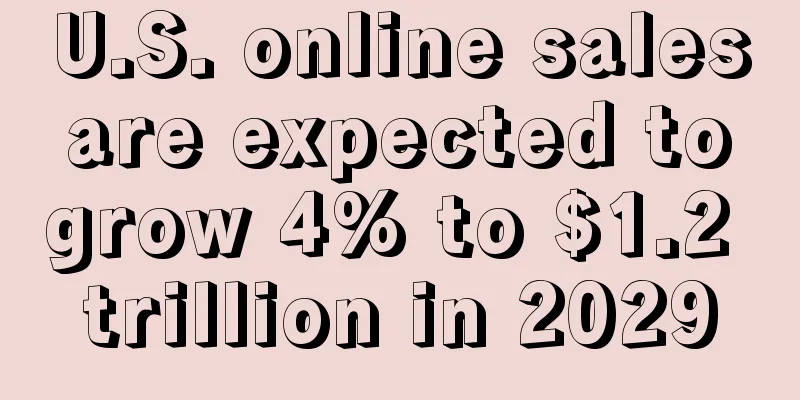U.S. online sales are expected to grow 4% to $1.2 trillion in 2029

|
It is learned that according to Forrester's latest "US Online Retail Forecast 2024-2029", by the end of this century, nearly 3 out of every 10 shopping trips by US consumers will be made online, and US online retail sales will reach 1.2 trillion US dollars in 2024. It will surge to 1.8 trillion US dollars in 2029, with a five-year compound annual growth rate (CAGR) of 8.4%, which will increase the share of e-commerce in total retail sales from 23.4% this year to 29.3%. The report pointed out that retail sales growth in 2023 has returned to pre-epidemic levels, with a total growth rate of 4.1%. Total retail sales are expected to grow by 4% in 2024, and total retail sales (excluding automobiles and gasoline) will increase from US$5 trillion this year to US$6 trillion in 2029, with a compound annual growth rate of 3.7%. It is worth noting that non-durable goods categories still have huge growth potential in online retail, and by 2029, the online penetration rate of clothing, flowers, shoes, pets and toys will exceed 50%. The total online retail penetration rate of non-durable goods such as groceries and beauty products is only half of that of durable goods categories, and there is still a lot of market space. Most non-durable goods categories have an online retail penetration rate of less than 40%, and online sales in these categories will achieve double-digit or high-single-digit growth in the next few years. The popularity of same-day delivery and subscription services will further drive the growth of online grocery, and detailed product information, customer reviews and recommendations will help drive online sales growth of personal care, nutritional supplements, medical supplies and over-the-counter drugs. Affordable goods from e-commerce platforms such as Shein and Temu, although with longer delivery times, are more likely to have a positive impact on e-commerce sales of products such as clothing and footwear. Additionally, buy online, pick up in store (BOPIS) is considered a portion of total e-commerce sales, with sales set to reach $196 billion by 2029, accounting for 29% of online sales for omnichannel retailers in the U.S. BOPIS has gained momentum during the pandemic, and even after the pandemic is over, it remains popular with many consumers. Durable goods (sometimes called hard goods, which include categories such as consumer electronics, tools and home improvement, furniture, small appliances, office supplies, and auto parts) have high e-commerce penetration overall, with half of the categories exceeding 40%. Tools, home improvement, and furniture categories, which currently have low online penetration, are likely to achieve double-digit growth in the future. Amazon and Walmart are increasingly dominant in the broader retail market, with Amazon accounting for 43% of all online retail sales in the U.S. in 2023, while Walmart accounts for 11%. It is predicted that if current trends continue through 2029, the two companies will together generate $1.5 trillion in total sales (physical and online), accounting for about a quarter of the projected $6 trillion in total U.S. retail sales. In terms of online sales alone, Amazon and Walmart will generate $1.1 trillion in sales by 2029, accounting for two-thirds of all e-commerce sales in the United States. However, as market concentration increases, the strong growth of Amazon and Walmart may trigger antitrust scrutiny, and the U.S. Federal Trade Commission (FTC) case against Amazon will go to trial at the end of 2026. The two companies use big data and artificial intelligence technology to enhance customer experience, but this also puts small retailers under greater competitive pressure. The vast amounts of consumer data collected by Amazon and Walmart allow them to improve recommendations, marketing, and logistics while employing advanced technologies such as artificial intelligence, data analytics, and supply chain optimization to enhance the customer experience, ultimately creating a cycle that solidifies their market dominance. But smaller businesses may struggle to keep up with these innovations and their high-margin alternative revenue streams. Author✎ Summer/ |
>>: U.S. holiday online sales to reach $240.8 billion in 2024, up 8.4%
Recommend
How do Amazon sellers create their own logo? You need some skills and tools
Many sellers initially think that selling product...
What are long-tail keywords? A brief discussion on the role of long-tail keywords
Long-tail keywords are easily confused with short-...
What is Moshi.com? Moshi.com Review
Moximoxi.net is an e-commerce website focusing on ...
More than 200 people were defrauded of nearly 1 million yuan! Amazon service providers cut leeks and ran away!
▲ Video account focuses on cross-border navigation...
eBay predicts that Mexico will usher in a new wave of cross-border e-commerce boom!
eBay123 learned that according to Statista data, M...
2021 US Christmas sales reached 886.7 billion US dollars! A record high in 20 years!
It is learned that according to the National Retai...
Some Ways to Clear Inventory on Amazon
It is said that the off-season is for marketing a...
Please check out the 2021 Annual Report for Amazonians
In the blink of an eye, all cross-border people ha...
What is Farfetch? Farfetch Review
Farfetch is a global fashion luxury website that c...
Sellers’ Voices丨The Hardships of Small Sellers and Prime Day
Today we bring you a series of seller stories. Th...
TikTok marketing is all the rage in the fashion industry! It may become the next growth engine for fashion e-commerce
<span data-shimo-docs="[[20," ","...
What is AMZBase? AMZBase Review
AMZBase is a free and useful tool that helps you s...
Key points! The most complete solution to Amazon FBA inventory backlog!
▶ Video account attention cross-border navigation ...
Memorial Day is a shopping day! More than 90% of American celebrants plan to shop!
According to the "Second Quarter Holiday Prev...
What is shanghai-customs? shanghai-customs review
shanghai-customs offers a unique combination of in...









